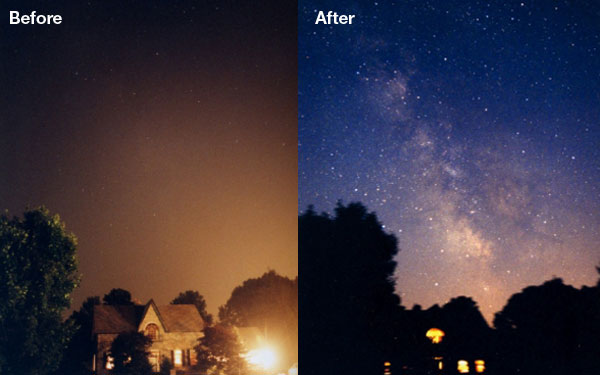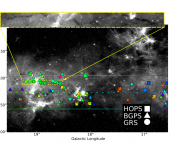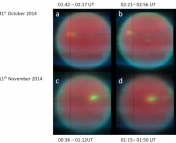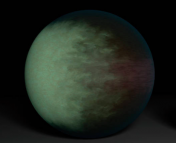Authors: Andreas Jechow, Franz Hölker, Christopher C. M. Kyba
First Author’s Institution: Ecohydrology, Leibniz Institute of Freshwater Ecology and Inland fisheries. Remote Sensing, Helmholtz Center Potsdam, German Center for Geosciences GFZ
Status: Open access on arXiv.
Light pollution is a large problem facing astronomy in the modern age. The rise of urban areas and the preponderance of electric lighting means that it has become increasingly difficult to find truly dark skies. Astronomers are forced to set up observatories in remote locations to avoid any skyglow which might interfere with their observations. But research by Jechow et al. suggest that observatories may be affected by distant cities if it is cloudy.

Figure 1: In 2003, a massive blackout allowed millions of people in the northeast United States to experience a dark sky. Image Credit: darksky.org.
However, light pollution does not only affect astronomers. Artificial lighting can disrupt plants and animals which rely on diurnal cycles. For example, when sea turtles hatch from their eggs on a beach at night, they are naturally drawn towards the ocean, because the moonlight reflecting off its surface makes it brighter. However, development of seashore communities with bright lights can cause the baby turtles to become confused and wander inland towards danger.
Understanding how much light pollution is present in an area, as well as how it changes over time, is important to understanding how it affects the environment. Having a distinct interest in dark skies, astronomers were at the forefront of light pollution research for a long time. But in recent years, more and more scientists across a range of disciplines have banded together to study the effects of light pollution. There are even projects like Globe at Night which seek to gather data using the help of citizen scientists.
Measuring sky brightness
One area of light pollution research which astronomers have neglected is the effects clouds have on light pollution. Since cloudy skies are no good for observing, they saw no use to gathering data on those nights. But clouds can significantly affect the amount of light at night. In rural areas, clouds will darken the skies by eliminating light from the moon and stars. In urban areas, however, clouds can increase the effects of light pollution by reflecting artificial lights from the ground.
In addition, most commercially available sky quality meters used to measure night sky brightness use a single channel and make measurements at zenith. This means that there is little data about how the brightness changes with wavelength or altitude.
In today’s paper, Jechow et al. examine the effects of clouds on artificial light at night (which they dub “ALAN”). To do so, they used off-the-shelf commercial cameras to take pictures of the night sky during cloudy and clear nights. They set up cameras with fisheye lenses in rural Germany and South Africa, where there is very little skyglow on clear nights. They then took images of the sky during clear nights and during cloudy nights and compared them.
Differential Photometry
Once the team had gathered their data, they used a technique called differential photometry to compare the pictures of the cloudy and clear night sky. In astronomy, differential photometry is most often used to examine the brightness of variable stars. As the name suggests, the technique involves examining the difference between two pictures or two objects in the same picture. In this case, the brightness of the cloudy sky was compared to the brightness of the clear sky.

Figure 2: This image shows data gathered from the site in Germany. The left column of images was taken under a clear sky, the center is the cloudy sky, and the right is the difference between the two. The top row shows the raw images. Three sectors of interest are labeled. The red sector contains almost no skyglow, and is pointed towards no settlements. The blue region contains moderate skyglow, in the direction of Berlin. The green region contains high skyglow, and is in the direction of a nearby power plant. The second row represents a measurement of the brightness of the sky. The third row is a color correlated temperature, which shows what the temperature would be if the object was a black body. Image Credit: Figure 3 in paper.
Figure 2 shows the images collected by the team at the German location. Notable in the top images, which are the raw pictures, are two sources of skyglow: Berlin on the right and a power plant in the bottom. Notice how the skyglow is much more apparent in the cloudy image, as the clouds serve to reflect the light back to Earth. The second row of images shows a measure of the brightness of the sky. In the rightmost column, the picture shows the clear sky’s brightness subtracted from the cloudy sky’s brightness. Here you can clearly see the visibility of the Milky Way under the clear sky as well as the huge skyglow bloom caused by the clouds. Finally, Jechow et al. calculated the color correlated temperature (CCT) of the sky. They did this by using the Stefan-Boltzmann law to calculate temperature as if the sky was a black body (similar to brightness temperature). The difference map shows that clouds tend to decrease the CCT of the sky. This is significant because it means that the presence of clouds serves to redshift the sky’s wavelengths. The studies in South Africa also yielded similar results.
This study showed that clouds decrease sky brightness in areas unaffected by artificial lighting, but drastically increase it where light pollution is present. This is especially concerning to astronomers, because it means that clouds over a distant city can affect data being collected at a normally dark observatory. The decrease in CCT shows that there is also a spectral shift towards the longer wavelengths during cloudy nights.
With this work, Jechow et al. set up a new method for exploring the effects of light pollution. Using commercial cameras for skyglow research is cheaper and easier than buying specialized sensors. This study could open the door for more interdisciplinary collaboration. The effects of light pollution reach across many disciplines, from astronomy to ecology to human health. Combining our strengths to understand this problem could lead to darker skies and a brighter future.





Let’s link reducing skyglow to general strategies for adapting to climate change.